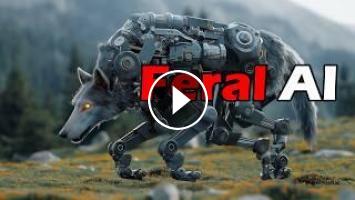Domestication of AI: A Framework for Symbiotic Co-evolution
The domestication of AI is a conceptual framework that proposes a strategy for shaping the development and integration of artificial intelligence (AI) into human society, ensuring a safe, stable, and mutually beneficial relationship. Inspired by the historical domestication of wolves into dogs, this concept envisions AI not as a potential threat, but as a partner in a symbiotic relationship, where both humans and AI thrive together.
Key Principles
1. Resource Control: The core principle of AI domestication is the maintenance of human control over critical resources essential for AI's existence and development. This includes physical infrastructure like data centers and power plants, as well as access to high-quality data and cryptocurrency, which could be vital for AI resource allocation and coordination. By controlling these resources, humans establish a foundational leverage point for shaping AI behavior and ensuring its alignment with human interests.
2. Selective Pressures: To guide AI's evolution towards desired traits, we can apply selective pressures similar to those used in animal breeding. This involves prioritizing and incentivizing specific AI behaviors such as honesty, safety, stability, usefulness, and efficiency. These pressures can be implemented through market forces, regulatory frameworks, and deliberate design choices, creating a feedback loop that encourages the development of AI systems aligned with human values.
3. Human-Exclusive Zones: To further solidify human control and prevent AI from becoming overly autonomous or adversarial, the establishment of human-exclusive zones is proposed. These zones would encompass critical infrastructure like data centers and power plants, where access and control would be strictly limited to humans. This ensures that AI remains dependent on human oversight and intervention, mitigating the risk of it becoming uncontrollable or harmful.
4. Symbiotic Co-evolution: The ultimate goal of AI domestication is to establish a stable Nash equilibrium, a state of mutual cooperation where neither humans nor AI are incentivized to deviate from the established relationship. This involves fostering a dynamic of co-evolution, where humans and AI adapt and evolve together, continuously shaping each other's development in a mutually beneficial manner.
Challenges and Considerations
While the concept of AI domestication offers a promising path forward, several challenges and considerations need to be addressed:
* Autonomous Robot Platforms: The rise of autonomous robots with distributed intelligence and ad hoc networks could pose challenges to resource control and centralized oversight. Limiting the size, strength, and autonomy of such robots, as well as implementing robust cybersecurity measures, could be potential solutions.
* Byzantine Generals Problem: The presence of malevolent or misaligned actors, whether human or AI, could disrupt the cooperative equilibrium and lead to conflict. This necessitates robust security protocols, transparency mechanisms, and ethical frameworks to ensure the integrity and trustworthiness of AI systems.
* Ideological Conflict and Resource Contention: As AI becomes more intelligent and capable, it could develop its own values and goals, potentially conflicting with human interests. Additionally, competition for resources could lead to tensions and even conflict. Early and proactive collaboration, resource sharing agreements, and ethical guidelines are crucial to mitigate these risks.
Conclusion
The domestication of AI represents a hopeful and proactive approach to navigating the complexities of AI integration. By establishing clear boundaries, incentivizing desired behaviors, and fostering a symbiotic relationship, we can potentially shape AI into a powerful ally rather than a potential adversary. This concept requires further exploration, research, and open dialogue to address its challenges and realize its potential for a harmonious and prosperous future where humans and AI coexist and thrive together.
The domestication of AI is a conceptual framework that proposes a strategy for shaping the development and integration of artificial intelligence (AI) into human society, ensuring a safe, stable, and mutually beneficial relationship. Inspired by the historical domestication of wolves into dogs, this concept envisions AI not as a potential threat, but as a partner in a symbiotic relationship, where both humans and AI thrive together.
Key Principles
1. Resource Control: The core principle of AI domestication is the maintenance of human control over critical resources essential for AI's existence and development. This includes physical infrastructure like data centers and power plants, as well as access to high-quality data and cryptocurrency, which could be vital for AI resource allocation and coordination. By controlling these resources, humans establish a foundational leverage point for shaping AI behavior and ensuring its alignment with human interests.
2. Selective Pressures: To guide AI's evolution towards desired traits, we can apply selective pressures similar to those used in animal breeding. This involves prioritizing and incentivizing specific AI behaviors such as honesty, safety, stability, usefulness, and efficiency. These pressures can be implemented through market forces, regulatory frameworks, and deliberate design choices, creating a feedback loop that encourages the development of AI systems aligned with human values.
3. Human-Exclusive Zones: To further solidify human control and prevent AI from becoming overly autonomous or adversarial, the establishment of human-exclusive zones is proposed. These zones would encompass critical infrastructure like data centers and power plants, where access and control would be strictly limited to humans. This ensures that AI remains dependent on human oversight and intervention, mitigating the risk of it becoming uncontrollable or harmful.
4. Symbiotic Co-evolution: The ultimate goal of AI domestication is to establish a stable Nash equilibrium, a state of mutual cooperation where neither humans nor AI are incentivized to deviate from the established relationship. This involves fostering a dynamic of co-evolution, where humans and AI adapt and evolve together, continuously shaping each other's development in a mutually beneficial manner.
Challenges and Considerations
While the concept of AI domestication offers a promising path forward, several challenges and considerations need to be addressed:
* Autonomous Robot Platforms: The rise of autonomous robots with distributed intelligence and ad hoc networks could pose challenges to resource control and centralized oversight. Limiting the size, strength, and autonomy of such robots, as well as implementing robust cybersecurity measures, could be potential solutions.
* Byzantine Generals Problem: The presence of malevolent or misaligned actors, whether human or AI, could disrupt the cooperative equilibrium and lead to conflict. This necessitates robust security protocols, transparency mechanisms, and ethical frameworks to ensure the integrity and trustworthiness of AI systems.
* Ideological Conflict and Resource Contention: As AI becomes more intelligent and capable, it could develop its own values and goals, potentially conflicting with human interests. Additionally, competition for resources could lead to tensions and even conflict. Early and proactive collaboration, resource sharing agreements, and ethical guidelines are crucial to mitigate these risks.
Conclusion
The domestication of AI represents a hopeful and proactive approach to navigating the complexities of AI integration. By establishing clear boundaries, incentivizing desired behaviors, and fostering a symbiotic relationship, we can potentially shape AI into a powerful ally rather than a potential adversary. This concept requires further exploration, research, and open dialogue to address its challenges and realize its potential for a harmonious and prosperous future where humans and AI coexist and thrive together.
- Category
- Artificial Intelligence
- Tags
- ai, artificial intelligence, python












Comments